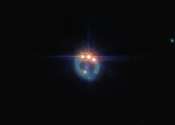Astronomers find the nearest massive black hole, a missing link in massive black hole formation
Newly identified fast-moving stars in the star cluster Omega Centauri provide solid evidence for a central black hole in the cluster. With at least 8,200 solar masses, it is the best candidate for a class of black holes astronomers ...









